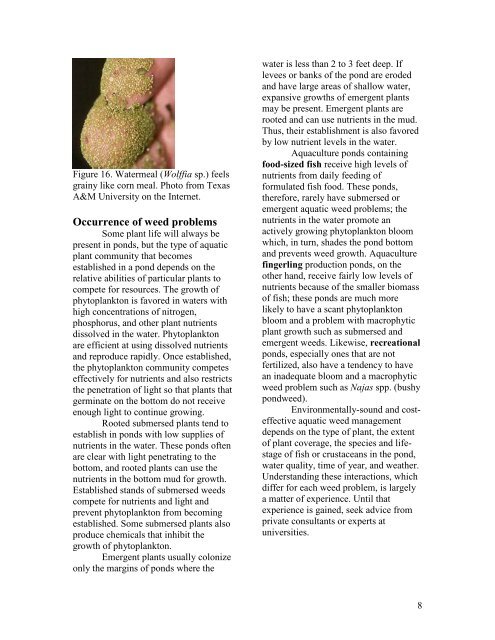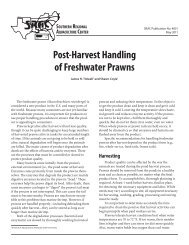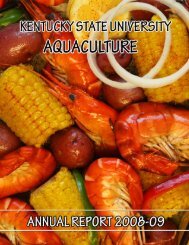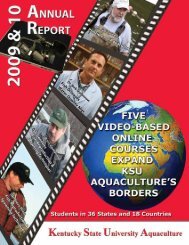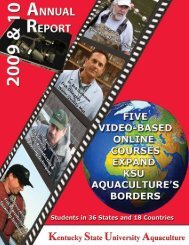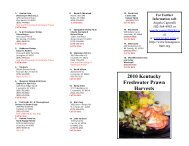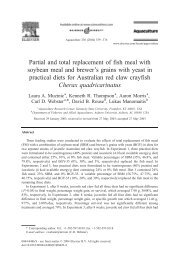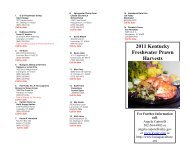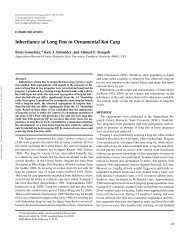Aquatic Weed Control in Ponds - Aquaculture at Kentucky State ...
Aquatic Weed Control in Ponds - Aquaculture at Kentucky State ...
Aquatic Weed Control in Ponds - Aquaculture at Kentucky State ...
You also want an ePaper? Increase the reach of your titles
YUMPU automatically turns print PDFs into web optimized ePapers that Google loves.
Figure 16. W<strong>at</strong>ermeal (Wolffia sp.) feelsgra<strong>in</strong>y like corn meal. Photo from TexasA&M University on the Internet.Occurrence of weed problemsSome plant life will always bepresent <strong>in</strong> ponds, but the type of aqu<strong>at</strong>icplant community th<strong>at</strong> becomesestablished <strong>in</strong> a pond depends on therel<strong>at</strong>ive abilities of particular plants tocompete for resources. The growth ofphytoplankton is favored <strong>in</strong> w<strong>at</strong>ers withhigh concentr<strong>at</strong>ions of nitrogen,phosphorus, and other plant nutrientsdissolved <strong>in</strong> the w<strong>at</strong>er. Phytoplanktonare efficient <strong>at</strong> us<strong>in</strong>g dissolved nutrientsand reproduce rapidly. Once established,the phytoplankton community competeseffectively for nutrients and also restrictsthe penetr<strong>at</strong>ion of light so th<strong>at</strong> plants th<strong>at</strong>germ<strong>in</strong><strong>at</strong>e on the bottom do not receiveenough light to cont<strong>in</strong>ue grow<strong>in</strong>g.Rooted submersed plants tend toestablish <strong>in</strong> ponds with low supplies ofnutrients <strong>in</strong> the w<strong>at</strong>er. These ponds oftenare clear with light penetr<strong>at</strong><strong>in</strong>g to thebottom, and rooted plants can use thenutrients <strong>in</strong> the bottom mud for growth.Established stands of submersed weedscompete for nutrients and light andprevent phytoplankton from becom<strong>in</strong>gestablished. Some submersed plants alsoproduce chemicals th<strong>at</strong> <strong>in</strong>hibit thegrowth of phytoplankton.Emergent plants usually colonizeonly the marg<strong>in</strong>s of ponds where thew<strong>at</strong>er is less than 2 to 3 feet deep. Iflevees or banks of the pond are erodedand have large areas of shallow w<strong>at</strong>er,expansive growths of emergent plantsmay be present. Emergent plants arerooted and can use nutrients <strong>in</strong> the mud.Thus, their establishment is also favoredby low nutrient levels <strong>in</strong> the w<strong>at</strong>er.<strong>Aquaculture</strong> ponds conta<strong>in</strong><strong>in</strong>gfood-sized fish receive high levels ofnutrients from daily feed<strong>in</strong>g offormul<strong>at</strong>ed fish food. These ponds,therefore, rarely have submersed oremergent aqu<strong>at</strong>ic weed problems; thenutrients <strong>in</strong> the w<strong>at</strong>er promote anactively grow<strong>in</strong>g phytoplankton bloomwhich, <strong>in</strong> turn, shades the pond bottomand prevents weed growth. <strong>Aquaculture</strong>f<strong>in</strong>gerl<strong>in</strong>g production ponds, on theother hand, receive fairly low levels ofnutrients because of the smaller biomassof fish; these ponds are much morelikely to have a scant phytoplanktonbloom and a problem with macrophyticplant growth such as submersed andemergent weeds. Likewise, recre<strong>at</strong>ionalponds, especially ones th<strong>at</strong> are notfertilized, also have a tendency to havean <strong>in</strong>adequ<strong>at</strong>e bloom and a macrophyticweed problem such as Najas spp. (bushypondweed).Environmentally-sound and costeffectiveaqu<strong>at</strong>ic weed managementdepends on the type of plant, the extentof plant coverage, the species and lifestageof fish or crustaceans <strong>in</strong> the pond,w<strong>at</strong>er quality, time of year, and we<strong>at</strong>her.Understand<strong>in</strong>g these <strong>in</strong>teractions, whichdiffer for each weed problem, is largelya m<strong>at</strong>ter of experience. Until th<strong>at</strong>experience is ga<strong>in</strong>ed, seek advice frompriv<strong>at</strong>e consultants or experts <strong>at</strong>universities.8


